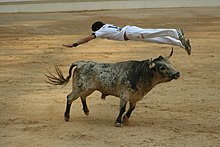
A rodeo clown, bullfighter or rodeo protection athlete, is a rodeo performer who works in bull riding competitions. Originally, the rodeo clown was a single job combining "bullfighting" — the protection of riders thrust from the bull, as well as being an individual who provided comic relief. Today, the job is split into two separate ones: bullfighters who protect the riders from the bull, and entertainers (barrelmen) who provide comic humor. However, in some parts of the world and at some small rodeos, the jobs of bull rider protection and comic remain combined.

A running of the bulls is an event that involves running in front of a small group of bulls, typically six but sometimes ten or more, that have been let loose on sectioned-off streets in a town, usually as part of a summertime festival. Particular breeds of cattle may be favored, such as the toro bravo in Spain, also often used in post-run bullfighting, and Camargue cattle in Occitan France, which are not fought. Bulls are typically used in such events.
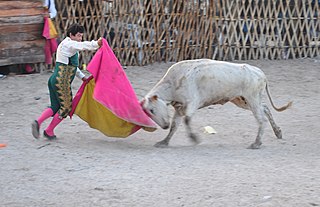
A bullfighter is a performer in the activity of bullfighting. Torero or toureiro, both from Latin taurarius, are the Spanish and Portuguese words for bullfighter, and describe all the performers in the activity of bullfighting as practised in Spain, Portugal, Mexico, Peru, France, Colombia, Ecuador, Venezuela and other countries influenced by Portuguese and Spanish culture. The main performer and leader of the entourage in a bullfight, and who finally kills the bull, is addressed as maestro (master), or with the formal title matador de toros. The other bullfighters in the entourage are called subalternos and their suits are embroidered in silver as opposed to the matador's gold. They include the picadores, rejoneadores, and banderilleros.

Bull-leaping is a term for various types of non-violent bull fighting. Some are based on an ancient ritual from the Minoan civilization involving an acrobat leaping over the back of a charging bull. As a sport it survives in modern France, usually with cows rather than bulls, as course landaise; in Spain, with bulls, as recortes and in Tamil Nadu, India with bulls as Jallikattu.

A bullring is an arena where bullfighting is performed. Bullrings are often associated with the Iberian Peninsula, but they can also be found through Iberian America and in a few Spanish and Portuguese ex-colonies in Africa. Bullrings are often historic and culturally significant centres that bear many structural similarities to the Roman amphitheatre.
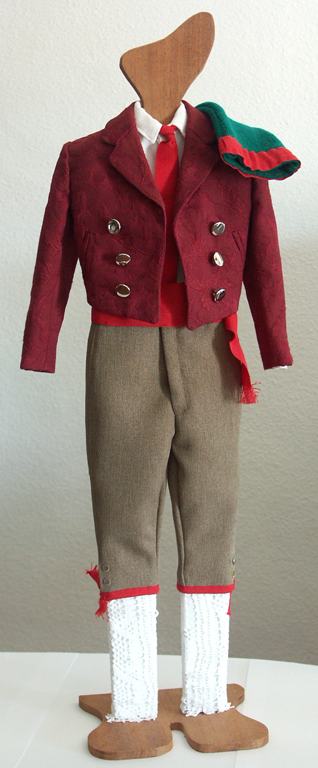
A forcado is a member of a group of men that performs the pega de cara or pega de caras, the final event in a typical Portuguese bullfight. The only Spanish-style bullfighting where forcados may also be present are Mexican bullfights. Forcados were initially professionals from lower classes but nowadays people from all social backgrounds practice their art through amateur groups.
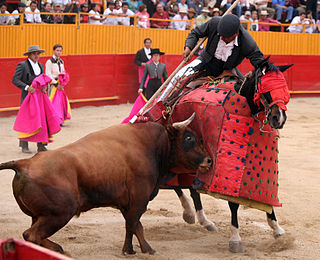
A picador is one of the pair of horse-mounted bullfighters in a Spanish-style bullfight that jab the bull with a lance. They perform in the tercio de varas, which is the first of the three stages in a stylized bullfight.

The Spanish Fighting Bull is an Iberian heterogeneous cattle population. It is exclusively bred free-range on extensive estates in Spain, Portugal, France and Latin American countries where bullfighting is organized. Fighting bulls are selected primarily for a certain combination of aggression, energy, strength and stamina. In order to preserve their natural traits, during breeding the bulls rarely encounter humans, and if so, never encounter them on foot.

Spanish-style bullfighting is a type of bullfighting that is practiced in several Spanish-speaking countries: Spain, Mexico, Ecuador, Venezuela, Peru, as well as in parts of southern France and Portugal. In Colombia it has been outlawed but is being phased out with a full ban coming in effect in 2027. This style of bullfighting involves a physical contest with humans attempting to publicly subdue, immobilize, or kill a bull. The most common bull used is the Spanish Fighting Bull, a type of cattle native to the Iberian Peninsula. This style of bullfighting is seen to be both a sport and performance art. The red colour of the cape is a matter of tradition – bulls are color blind. They attack moving objects; the brightly-colored cape is used to mask blood stains.

Portuguese-style bullfighting differs in many aspects from Spanish-style bullfighting, most notably in the fact that the bull is not killed in front of an audience in the arena. The cavaleiros and the forcados are unique to the Portuguese variety of bullfighting, as well as the participation of horsewomen (cavaleiras) in the routines.

The course landaise is an ancient form of bullfighting and bull-leaping held in oval or rectangular arenas covered in sand, that involves no bloodshed. Experienced cows, with large horns, aged generally from 2 to 14 years old, are used instead of bulls. They are athletic but small animals selected from the same breed as the bulls used for the Spanish corridas. In Gascony, it is a major spectator sport, counting as many as 600 events each year.

Bovine sports are sports that involve cattle, commonly a bull, ox, steer, cow or calf.
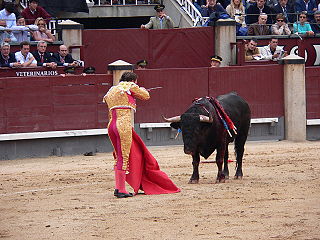
Bullfighting is a physical contest that involves a bullfighter attempting to subdue, immobilize, or kill a bull, usually according to a set of rules, guidelines, or cultural expectations.
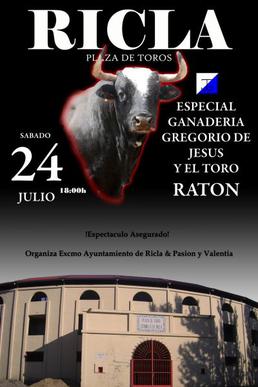
Ratón was a Spanish fighting bull that was nicknamed el toro asesino, el sangriento toro Raton and el terrible Ratón for killing three people in bullfighting rings in Spain during 2006–2011 and injuring thirty more. The bull became legendary in Spain due to the large number of gorings for which he was responsible. Bullfighting fans regarded him as a star and traveled from across the country to see the morlaco at his home at Sueca near Valencia. Matador Jesús Esteve said of Ratón: "He is a killer. He is lazy, he doesn't want to participate. He does his own thing, waiting for somebody to make a mistake. And then when he gets you, he wallops you, and he doesn't let up."

The traje de luces is the traditional clothing that Spanish bullfighters wear in the bullring. The term originates from the sequins and reflective threads of gold or silver. These trajes are based on the flamboyant costumes of the 18th-century dandies and showmen involved in bullfighting, which later became exclusive to the bullfighting ritual. Later adornments include the montera hat, more elaborate embroidery, and decorative accessories.
Bullfighting was banned in the Spanish autonomous community of Catalonia by a vote of the Catalan Parliament in July 2010. The ban came into effect on 1 January 2012. The last bullfight in the region took place on 25 September 2011 at La Monumental. The ban was officially annulled for being unconstitutional by Spain's highest court on 5 October 2016. However, despite the overturning of the ban, no further bullfight had taken place in Catalonia as of July 2020.

La Tauromaquia (Bullfighting) is a series of 33 prints created by the Spanish painter and printmaker Francisco Goya, which was published in 1816. The works of the series depict bullfighting scenes. There are also seven extra prints that were not published in the original edition.

Bull wrestling, cow fighting or bull fighting is a non-lethal human-facilitated bloodsport between bulls or cows found in some parts of the world.
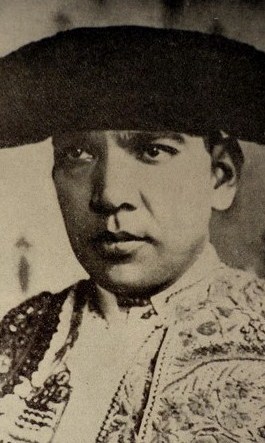
Rodolfo Gaona y Jiménez, was a Mexican bullfighter who performed from 1905 until his retirement in 1925, primarily in Madrid. Known as El Indio Grande and La Califa de León, Gaona was part of the Golden Age of bullfighting in Spain alongside Juan Belmonte and Joselito. He invented the gaonera and pase del centenario moves.
